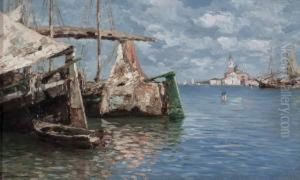Francesco Silvani Paintings
Francesco Silvani, an Italian architect and sculptor of the late Renaissance and early Baroque periods, was born in 1570 and passed away in 1646. His life and work are emblematic of the transition in European art from the graceful elegance of the Renaissance to the more dynamic and ornate expressions found in Baroque architecture. Although not as widely recognized as contemporaries like Bernini or Borromini, Silvani's contributions to architecture and sculpture during this pivotal era were significant, particularly in his native Italy.
Silvani's career was predominantly based in Northern Italy, where he left a lasting legacy through his designs of churches, palaces, and public buildings that blended the rational harmony of Renaissance principles with the emerging dynamism of Baroque style. His works are characterized by their intricate details, balanced proportions, and the subtle incorporation of sculptural elements that enhance the architectural narrative. One of his hallmark projects was the design of the facade of the Santa Maria in Organo in Verona, which showcases his skill in marrying architectural form with sculptural decoration to create a harmonious and visually appealing whole.
Despite his notable contributions, detailed records of Silvani's life and the full extent of his oeuvre are somewhat scarce, as is the case with many artists of his time. His training and early career are not well-documented, but it is believed that he was influenced by prominent figures of the Italian Renaissance and was possibly involved in some capacity with the work of Andrea Palladio, the eminent Venetian architect known for his classical approach. Silvani's work, however, suggests that he developed a distinctive style that, while rooted in the traditions of the past, anticipated the exuberance of Baroque art and architecture.
Throughout his career, Francesco Silvani remained committed to the principles of beauty, proportion, and harmony, but he was also unafraid to experiment with form and decoration. His buildings often feature a dynamic interplay between light and shadow, a hallmark of Baroque architecture, and his sculptures exude a sense of movement and emotional depth that were revolutionary at the time. Silvani's legacy is not only in the structures he designed but also in his influence on subsequent generations of architects and sculptors who looked to his work as a bridge between the Renaissance's order and the Baroque's complexity.
In conclusion, Francesco Silvani's life and work are a testament to the creative ferment of early 17th-century Italy, a time when artists and architects were exploring new ways to express the human experience through art. His contributions, while perhaps not as celebrated as those of his more famous peers, remain an important part of the architectural and sculptural canon of the period, reflecting the evolving tastes and ideas of an era poised between two great artistic movements.

